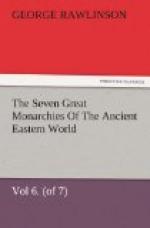It would seem that matters remained in this state for the space of about fifteen or sixteen years. When, however, Mithridates I. (Arsaces VI.), about B.C. 150, had overrun the eastern provinces of Syria, and made himself master in succession of Media, Elymais, and Babylonia, the revolutionary movement excited by his successes reached Armenia, and the standard of independence was once more raised in that country. According to the Armenian historians, an Arsacid prince, Wagharshag or Valarsaces, was established as sovereign by the influence of the Parthian monarch, but was allowed to rule independently. A reign of twenty-two years is assigned to this prince, whose kingdom is declared to have reached from the Caucasus to Nisibis, and from the Caspian to the Mediterranean. He was succeeded by his son, Arshag (Arsaces), who reigned thirteen years, and was, like his father, active and warlike, contending chiefly with the people of Pontus. At his death the crown descended to his son, Ardashes, who is probably the Ortoadistus of Justin.
Such were the antecedents of Armenia when Mithridates II., having given an effectual check to the progress of the Scythians in the east, determined to direct his arms towards the west, and to attack the dominions of his relative, the third of the Armenian Arsacidse. Of the circumstances of this war, and its results, we have scarcely any knowledge. Justin, who alone distinctly mentions it, gives us no details. A notice, however, in Strabo, which must refer to about this time, is thought to indicate with sufficient clearness the result of the struggle, which seems to have been unfavorable to the Armenians. Strabo says that Tigranes, before his accession to the throne, was for a time a hostage among the Parthians. As hostages are only given by the vanquished party, we may assume that Ortoadistus (Ardashes) found himself unable to offer an effectual resistance to the Parthian king, and consented after a while to a disadvantageous peace, for his observance of which hostages were required by the victor.
It cannot have been more than a few years after the termination of this war, which must have taken place towards the close of the second, or soon after the beginning of the first century, that Parthia was for the first time brought into contact with Rome.
The Great Republic, which after her complete victory over Antiochus III., B.C. 190, had declined to take possession of a single foot of ground in Asia, regarding the general state of affairs as not then ripe for an advance of Terminus in that quarter, had now for some time seen reason to alter its policy, and to aim at adding to its European an extensive Asiatic dominion. Macedonia and Greece having been absorbed, and Carthage destroyed (B.C. 148-146), the conditions of the political problem seemed to be so far changed as to render a further advance towards the east a safe measure; and accordingly, when it was seen that the line of the kings of Pergamus was coming to an




